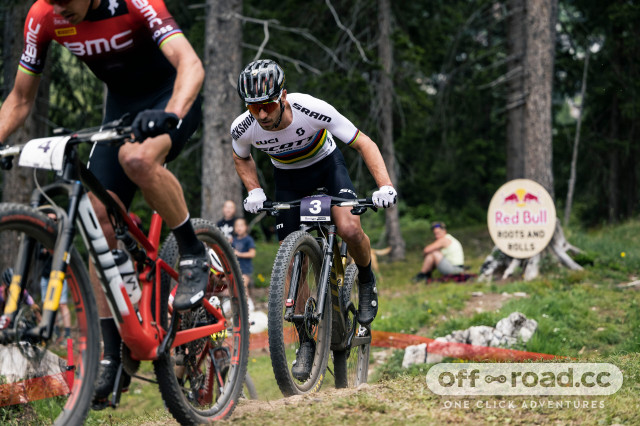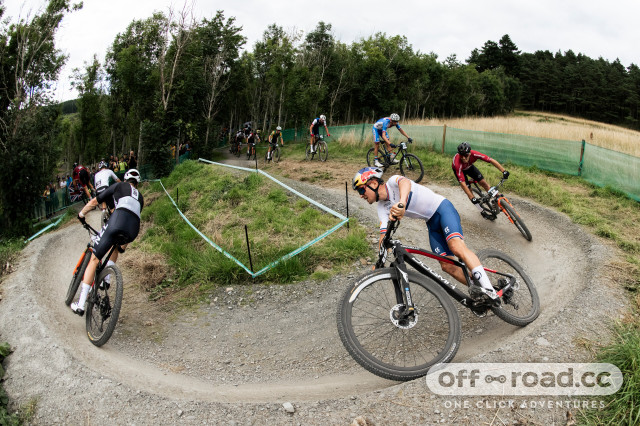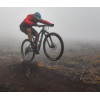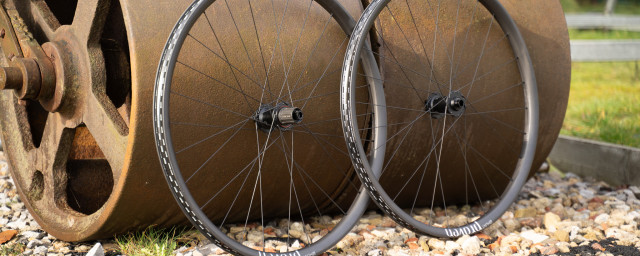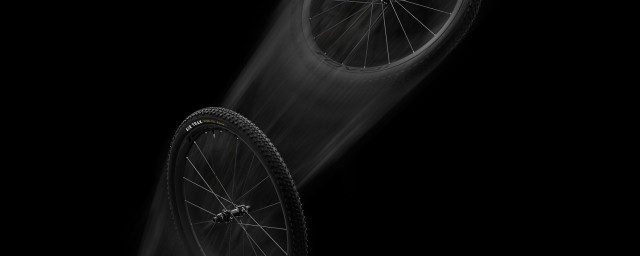Mountain bike tyre pressures – everything you need to know

Tyre pressure is a great paradox in off-road cycling and spans all disciplines such as mountain biking, cyclo-cross and gravel. Riders will obsess about all manner of mechanical adjustments that are more challenging than inflating or deflating their tyres but, in truth, the correct tyre pressure will dramatically improve your confidence on the bike.
- Best mountain bike tyres - quality rubber for trail, XC and enduro
- Types of bike tyres - how to find the best tyre option for you
- Best floor pumps for mountain and gravel bikes - top track pumps reviewed and rated
It is amazing how many off-road riders get tyre pressure wrong for something so straightforward to get right. But why? And how do you narrow into that bandwidth of ideal tyre pressure?
It’s best to start with what not to do. Don’t give in to peer pressure and catalogue most riders' mistakes with tyre pressure adjustment.
Don't follow the numbers on your tyre wall
If you follow the inflation guide on your mountain bike tyre sidewalls, you are guaranteed never to ride at the correct pressure. It might sound deeply counterintuitive but it is true.
Minimum and maximum inflation guides printed on your tyre sidewalls relate to legality and product litigation. Nearly every pro mountain biker rides below the minimum suggested threshold for their given tyres. The first step to getting your tyre pressures correct is to ignore whatever is recommended on your tyres.
Another mistake that too many riders make is using wildly inaccurate methods for gauging and adjusting tyre pressure. The finger pinch method is comically silly. Not even the most experienced and dexterous professional mountain bike mechanic could accurately measure tyre pressure by the forefinger-and-thumb test. And yet many riders will pinch their tyres by hand and muse,” Yeah, that feels about right”
Similar to the suspension setting fallacy, you can’t ride off a kerb at low speed to test your tyre pressure. The speed and impact angle are not relatable to real-world trail riding. So, if you’ve done the parking lot test to conclude that your tyres feel ‘good to session’, we hate to disappoint your enthusiasm, but they probably aren’t.
Nothing beats the accuracy of a handheld gauge
Being scientific and methodical is the only way to master tyre pressure. Don’t trust a regulation floor pump to always be in a state of accuracy, either. Floor pumps are great at inflating tyres, but their gauges can lack sensitivity and wear out of calibration over time, rendering inaccurate readings.
Tyre pressure adjustments should be made in small and accurate increments. And the only tool that works for that is a handheld digital tyre gauge, with a pressure release function. It’s accurate and can deflate in very small, controlled increments. Handheld tyre gauges last many years, only require replacement batteries and are a fantastic investment, considering how affordable they are.
You need to go lower than you think
Mountain biking revolutionised the way all riders think and approach tyre pressure. For decades reference tyre pressure wisdom was borrowed from road cycling - and it was way too high.
Overinflated tyres are awful to ride. Especially on a mountain bike, when rolling over off-road terrain. All those rocks, roots and other trail surface textures will ping you around and cause ‘terrain-steer’ if your tyres are overinflated. Lower pressures allow your tyres to work as the first contact point of suspension on your mountain bike, conforming and shaping with terrain, which benefits steering, braking and pedalling control.
Tubeless tyre technology heralded a breakthrough for off-road tyre engineering. Tubeless tyres allowed for much lower pressures without the risk of an inner tube being pinched by the rim and resulting in a flat tyre. The result? Enhanced off-road ride comfort and trail feedback.
Novice riders are often afraid of low tyre pressures, worried that their tyres will easily pinch flat when rolling across some roots or rocky terrain at speed. But this is rarely the case unless you run dramatically underinflated tyres.
The science behind bigger tyres and lower pressures
Lower inflation pressures work in alignment with your tyre size and rim width. The best mountain bike wheels and tyres have grown in size with the standardisation of tubeless technology, making mountain bikes much better on technical trails.
As professional riders discovered the benefit of tubeless tyre technology and lower pressures, engineers started tabling the advantage of bigger tyres mounted on wider rims.
How has the size trend in tyre casings and rim width changed over the last decade? Back in 2012, an average mountain bike tyre was 2.25in wide and mounted on a 23-25mm internal diameter rim. It is unusual to find any 2023 model-year trail mountain bike rolling tyres smaller than 2.4-inch in width, on rims narrower than 29mm.
On a narrow rim, a mid-sized tyre at low pressure has the risk of squirming and potentially suffering a bead disengagement if you corner at an extreme lean angle. Wider rims and larger casings create a more stable interface for tyres to corner and roll at lower pressures. For every millimetre of rim width you add, tyre pressure can safely be decreased, improving grip and overall bike control.
Finding that precious pressure bandwidth?
This is the trick question. Most riders use weight as a guiding logic, for their tyre pressure. Heavier riders need to ride higher pressures, but there are other variables like terrain, bike-type, and tyre size.
Greg Minnaar is the winningest downhill mountain biker of all time and, at nearly 200lb, a large rider. He runs a 29 x 2.5in front tyre on most of his bikes, inflated to 26psi, with a 29 x 2.4in at the rear, pressured at 28psi.
Compare Minnaar’s tyre pressures to that of the world’s best cross-country mountain biking racer, Nino Schurter. Riding bikes with much less suspension travel than Minnaar’s downhill and enduro rigs, Schurter runs 29 x 2.4in tyres, but they roll at much lower pressures, between 16 and 18psi. The Swiss rider only weighs only 147lb (66kg), but his 100mm dual-suspension cross-country bikes often have less than half of Minnaar’s downhill bike suspension travel, which rates at 215mm.
In a mountain biking discipline where climbing and descending are equally important, Schurter’s proven the value of going much lower with your mountain bike tyre pressure.
The argument for low pressures
To put it in the most direct way possible, less pressure equals more grip, to a point. That's because all off-road going tyres offer the most grip when they are allowed to deform the most.
This deformation means that the tyre's contact patch, and tread, can mould around small imperfections in the trail. Usually, mountain bikers aim to ride on the lowest tyre pressure possible without facing any of the downsides, with or without tyre inserts, which are another story in themselves.
Although, there are downsides. Because the tyre's contact patch is larger, decreased tyre pressures increase rolling resistance, so they'll be tougher to pedal. Low tyre pressures also result in reduced sidewall support and can struggle to fend off pinch punctures, which I'll elaborate upon in the next section.
You should consider lowering your tyre pressures if your ride is going to be particularly wet and slippery or if the terrain is soft. In these conditions, you're likely going to be riding slower and you won't be working your tyres as hard so pinch flats are far less common and the pitfalls of low pressures won't occur with as much a penalty.
A curious case for higher pressures
Are there scenarios where higher inflation pressures might be relevant? Of course. The main benefits of a higher tyre pressure are reduced rolling resistance, along with increased pinch flat, and rim protection. If you're planning a day munching miles and you don't want to contend with the higher rolling resistance of the larger surface area of a tyre with a lower tyre pressure, pump a few more PSI into your tyres and your pedalling will be a little easier.
An argument for inflating your tyres above your usual preference also comes when you're faced with rocky terrain. Higher pressures will keep the sidewalls of your tyres from coming into contact with your wheel's rim upon impact, drastically reducing the chances of dreaded pinch flats or snake bites. Your tyre pressure should also be considered when speed comes into play as the faster you go, the harder your tyres are going to impact trail obstacles.
High-speed berms and corners are another trail feature which can overwhelm tyres, on the lower inflation spectrum. This is due to the increased lateral load your tyres will experience. Hit a berm too hard with too little pressure and, likely, the tyre bead will temporarily (in the best case) break away from the rim. This is called burping and it results in a big loss of tyre pressure, and usually, a splash of sealant left behind. A higher tyre pressure offers better sidewall support that helps fend off tyre burps.
How to find the right tyre pressure for you
As you may have gathered by now, there are an awful lot of variables that go into tyre pressure as a subject, so it can get rather confusing but if you're just starting simply concentrate on what your bike is running and how things feel to you.
First, start with a reasonably high pressure – around 30psi is a good starting point for most riders. If you weigh above average, ride an e-bike or are using inner tubes consider adding a little more. From there, ride a trail and gradually lower the pressure of both tyres. As you do so, you will find that the tyres grip better, and you'll be sliding around less.
You'll know you've gone too far when the tyres feel as if they're squirming (moving too much on the rim) or if you're pinch flatting often. If so, add pressure incrementally until you find that sweet spot where your tyre is well-supported but is offering the most grip.
You'll also find that you may end up inflating your rear tyre more than the front in order to achieve lower rolling resistance and offer more protection as it's the rear wheel deals with more of the rider's weight in general. The front tyre provides most of your cornering grip and doesn't deal with as much abuse as the rear, so a slightly lower pressure is beneficial here.
Finding your tyre pressure can be a lengthy process but it gets easier with experience, though once you've found what's ideal for you, you can experiment a little more. As mentioned before, if it's wet you can drop the pressure for more grip and if the trails are bone dry and mega-fast, you can up the pressure for more sidewall protection.
I've already touched on this but there are some variables that'll change your tyre pressure. If you're running inner tubes or riding an e-bike every now then you will require a higher pressure for protection's sake. Tubeless setups, tyre inserts, stronger casings and larger tyre volumes offer an opportunity to lower the pressure even further as there's no tube at play, stronger casings and more air volume in the tyre.




